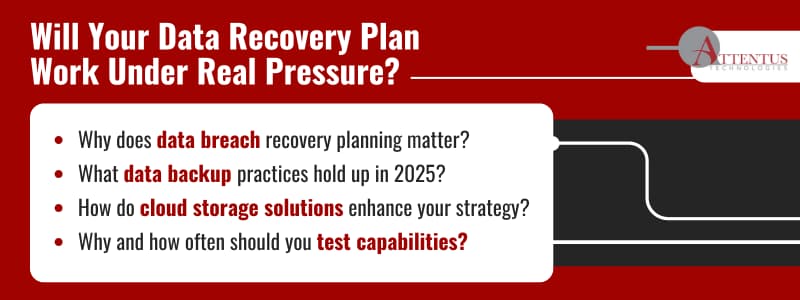Cyberattacks are a matter of when, not if. The best defense is a recovery plan built on resilient backups, a smart cloud strategy, and regular testing.

Could your business survive if every critical file vanished tomorrow?
Not to be alarmist, but let’s face it: hackers are on the offensive. Not a day passes by without a headline of another breach or ransomware attack. And it’s not just Fortune 500 companies that are affected: cybercriminals are putting SMBs like yours square in their crosshairs.
For instance, a 2025 Mastercard survey of over 5,000 SMBs in four continents reveals that 46% experienced a data breach, 20% of whom closed shop or filed for bankruptcy.
And if you think those figures are worrisome, consider this: 60% of SMBs shut down within six months of a major attack when there’s no tried-and-tested data breach recovery plan in place, according to Cybercrime Magazine.
The good news is that there are steps you can take to ensure your business doesn’t become another statistic. Ensure business continuity with strategic data backups and cloud storage solutions.
Here’s what to know about the modern data breach recovery playbook.
Why Data Breach Recovery Planning Matters
Before we get into data backups and cloud storage solutions, let’s dive into why you need them in the first place.
Avoiding business shutdown undoubtedly tops the list.
In September 2025, British automaker Jaguar Land Rover (JLR) had to halt operations in three factories for four weeks because of a cyberattack that caught them without a robust data breach recovery and insurance policy.
For JLR, each of those weeks meant that:
- 7,000 cars weren’t manufactured.
- $68 million was lost.
- 33,000 employees couldn’t work.
What’s at stake if your business shuts down for a day or week?
Beyond ensuring business operations run smoothly, proper planning can also protect your good reputation. According to the Mastercard survey cited above, SMBs suffer damaged partner and customer trust in 80% of data breaches.
Plus, even if your reputation goes unscathed, you may be on the hook for hefty fines, depending on the data regulation you’re subject to. All these are things you can avoid with the proactive data breach recovery measures covered below.
What’s my action item? Put a dollar figure on just one day of downtime for your business. This clarifies the value of planning ahead.
Best Practices for Data Backup in 2025
Now let’s discuss some of the steps you can take to stay proactive against cyberthreats.
#1. Apply The 3-2-1 Rule
What’s that? It’s a principle introduced in the late aughts (and still applies today) that requires you to:
- Store three data copies (the original + two more).
- On two different media (e.g., on a PC + an external hard drive).
- With one copy off-site (e.g., a cloud backup).
With that, you eliminate single points of failure.
#2. Automate with Cloud Storage Solutions
Why switch from manual backups? It’s simple. The person responsible for running the backup may be diligent about it. But at the end of the day, they are human, and therefore fallible.
One day, they will make a mistake or forget to initiate the backup entirely. What if that is the day there’s a breach?
Automated cloud storage solutions eliminate human error and provide better version control, allowing you to restore data to specific points in time.
#3. Use Immutable Data Backups
Immutable backups follow the “write once, read many” (WORM) security principle, meaning data can’t be modified once saved, thereby maintaining its integrity.
This makes it a robust protection measure against ransomware overwrites, accidental deletion, or any other form of tampering.
What’s my action item? Ask your MSP if your backups are encrypted, immutable, and replicated across multiple regions.
Cloud Storage Solutions That Strengthen Backup
So, should you store data on-premise or off-site? The smart strategy is to adopt a hybrid model, combining local and cloud backups for speed and resilience. This acts as an insurance policy against device failure or natural disaster at your primary location.
Cloud storage solutions offer the advantage of being easily scalable, enabling you to increase capacity without incurring massive hardware investments. And they can help you achieve geographic redundancy and simplify compliance, too.
One pitfall to avoid, however, is using “sync” tools like OneDrive or Google Drive as data backup solutions.
These aren’t true recovery systems because, for example, if a file on the physical device is deleted or infected by a virus, that event will be mirrored in the cloud. Only use a cloud storage solution that creates a separate, independent copy of your data.
What’s my action item? Confirm your provider offers dedicated cloud backup services, not just file sync.
Testing and Validating Your Data Backup Plan
Creating redundant data backups with the 3-2-1 rule and other discussed strategies is half the equation. Remember, backups are only valuable if they restore quickly and completely when you need them to.
And the only way to know for sure is to test and validate. Run quarterly recovery simulations to check if restores align with RPO (Recovery Point Objective) and RTO (Recovery Time Objective) metrics.
What’s my action item? Schedule one test restore per quarter and track how long it takes to recover.
Assigning Roles and Responsibilities
As you tackle the technical aspects of your backup disaster recovery plan, don’t forget to assign roles and responsibilities:
Define who:
- Triggers the recovery.
- Communicates with staff and clients.
- Coordinates with your MSP.
With no confusion about who does what, everyone can spring into action when disaster strikes, considerably reducing the recovery time. No more extended business disruption.
What’s my action item? Create a simple one-page responsibility chart today.
Backups Without Testing Are a False Sense of Security
A true recovery strategy means combining data backup, cloud storage solutions, and regular testing. Anything less is just hoping for the best.
This brings us to three final questions:
- Do you have a true recovery strategy?
- How are you backing up your data?
- When’s the last time you tested your plan?
Not sure?
Get Attentus Data Breach Recovery Help in 3-2-1…
At Attentus, one of our core values is to “be the answer” to our clients. One way is by helping them turn backup plans into real-world data breach recovery strategies that protect revenue and reputation.
We’d love to do the same for you! Let’s start with a data backup and recovery audit to ensure your business can bounce back from any breach or disaster.
